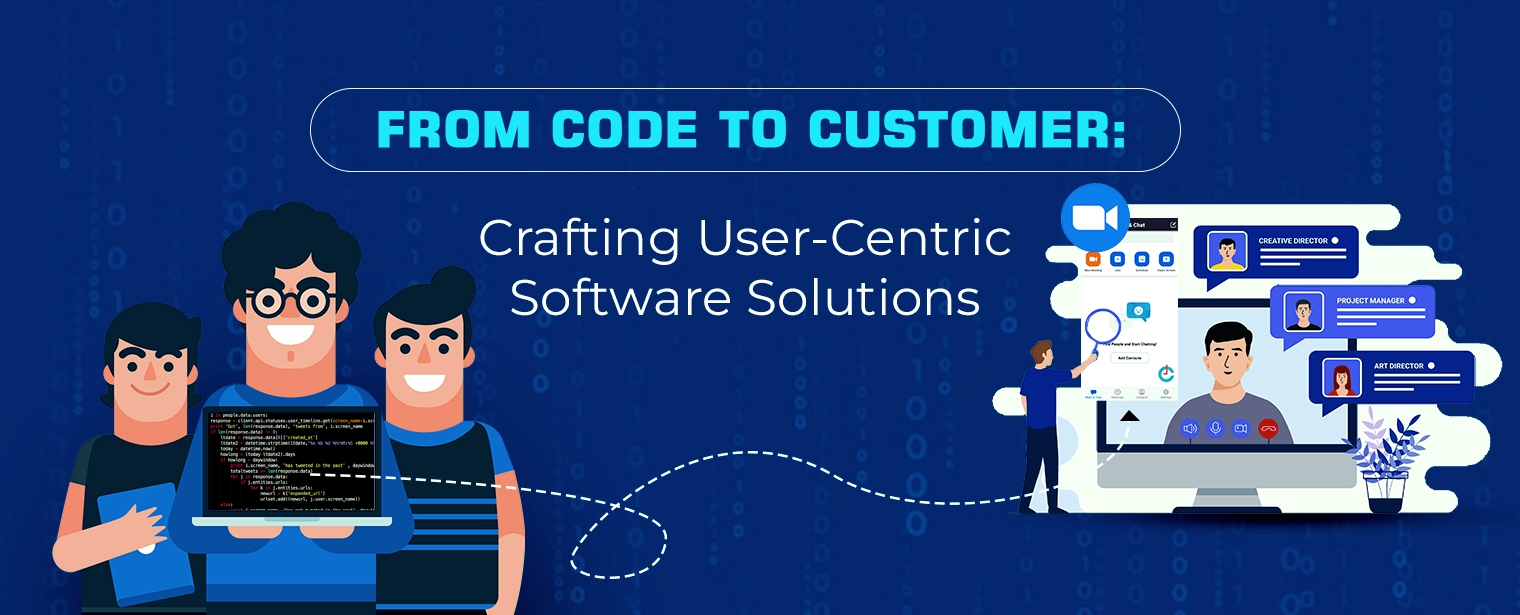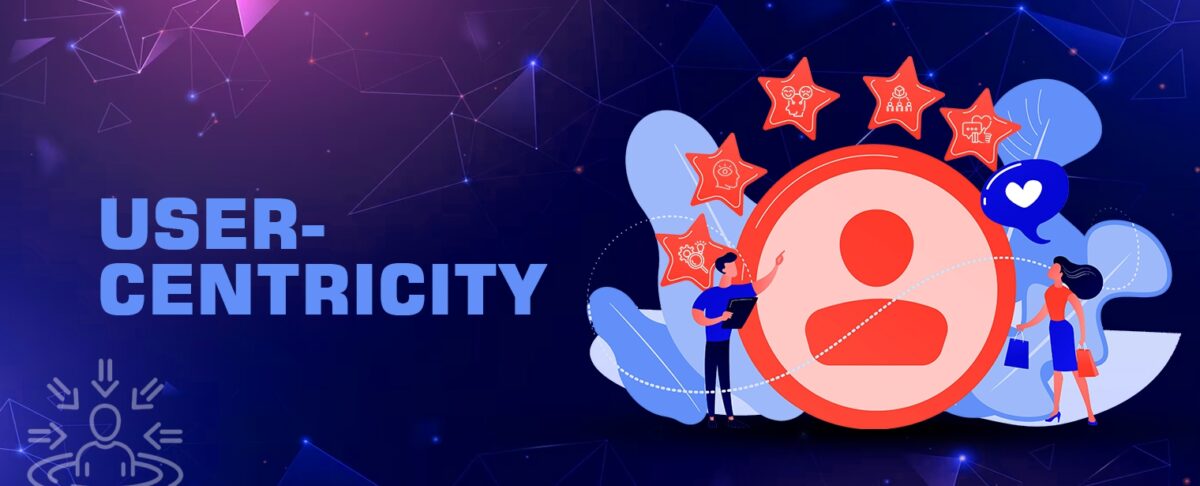From Code to Customer: Crafting User-Centric Software Solutions

Introduction
In the ever-evolving landscape of technology, the success of software solutions provided by a top software development company in India or elsewhere hinges not only on the elegance of the underlying code but, more importantly, on their ability to meet the needs and expectations of end-users. As the demand for user-centric experiences continues to rise, software developers are challenged to bridge the gap between code and customer satisfaction. In this blog, we’ll explore the journey from code to customer, emphasizing the importance of crafting user-centric software solutions.
Understanding User-Centricity

In the dynamic realm of software development, the spotlight is increasingly shifting towards user-centricity as a pivotal driving force. Understanding the user, their needs, and expectations has become the cornerstone of creating successful and impactful software solutions.
User-centricity transcends mere functionality; it delves into the very essence of user experience. The process begins with empathetic research, where developers immerse themselves in the user’s world, gaining insights into their challenges and aspirations. This understanding lays the foundation for intuitive design, ensuring that the software aligns seamlessly with user behavior.
Feedback becomes the lifeblood of user-centric development. Continuous iteration based on user input fosters a symbiotic relationship between developers and end-users, resulting in a product that evolves organically to meet changing needs. This iterative loop not only refines the software but also enhances user satisfaction and loyalty.
Moreover, prioritizing user-centricity is a strategic move. Satisfied users become advocates, driving organic growth and positive word-of-mouth. By prioritizing the human element in development, software transcends being a mere tool; it becomes a tailored solution that resonates with its users.
In conclusion, understanding user-centricity is not just a trend but a paradigm shift in software development. It is about building relationships, listening attentively, and crafting solutions that enhance the user’s journey. In a landscape where technology is ubiquitous, the true measure of success lies not just in lines of code but in the smiles and satisfaction of the end-users.
The Code Foundation
Before diving into the user-centric approach, it’s crucial to recognize the significance of a robust code foundation. Clean, efficient, and maintainable code forms the bedrock upon which user-centric software is built. Developers must prioritize best coding practices, adhere to coding standards, and employ methodologies that ensure scalability and flexibility. A well-structured codebase not only facilitates easier maintenance and updates but also serves as the canvas upon which the user-centric elements will be painted.
User Research and Persona Development
To truly understand the end-user, developers must conduct thorough user research. This involves collecting data on user behaviors, preferences, and pain points through methods such as surveys, interviews, and usability testing. This data serves as the foundation for creating user personas—fictional representations of the target audience. These personas encapsulate the diverse needs and expectations of users, guiding the development process with a user-centric focus.
Iterative Design and Prototyping

The iterative design process is a key component of user-centric software development. Instead of relying on a linear development model, developers create prototypes and iterate through design cycles based on user feedback. This agile approach allows for continuous refinement and improvement, ensuring that the final product aligns closely with user expectations. Prototypes serve as a tangible representation of the software, enabling users to provide feedback on the interface, functionality, and overall usability.
User Interface (UI) and User Experience (UX) Design

In the ever-evolving landscape of digital technology, User Interface (UI) and User Experience (UX) Design stand as the keystones of user-centric software development. UI, the visual interface that users interact with, and UX, the overall experience users have with a product, collaboratively shape the success and adoption of software.
A well-crafted UI enhances usability by providing an intuitive and visually appealing layout. It’s the first impression, a virtual handshake that influences user engagement. An aesthetically pleasing UI contributes to a positive user perception, building trust and encouraging continued interaction.
UX, on the other hand, goes beyond aesthetics, focusing on the entire user journey. It encompasses factors like accessibility, responsiveness, and overall satisfaction. Seamless navigation, minimal friction, and a user-friendly environment lead to a positive UX, fostering user loyalty.
Together, UI and UX design create a symbiotic relationship, ensuring that software not only looks good but also functions effortlessly. User-centric design considers the needs, preferences, and behaviours of the end user, resulting in an interface that feels tailor-made.
In essence, investing in UI and UX design is investing in user satisfaction. Software that prioritizes these elements becomes more than a tool; it becomes an experience. As technology continues to advance, the pivotal roles of UI and UX design in shaping user-centric software will remain indispensable.
Accessibility and Inclusivity
User-centric software goes beyond catering to the majority and embraces inclusivity. Accessibility features ensure that the software is usable by individuals with diverse abilities and disabilities. This involves considerations such as providing alternative text for images, keyboard navigation options, and compatibility with screen readers. By prioritizing accessibility, developers enhance the reach and impact of their software, making it available to a broader audience.
Performance Optimization
User satisfaction is closely tied to the performance of the software. Slow load times, frequent crashes, and sluggish responsiveness can significantly impact the user experience. Developers must prioritize performance optimization, employing techniques such as code profiling, caching, and efficient algorithms. A responsive and stable software application contributes to a positive user perception and fosters trust in the product.
Feedback Loops and Continuous Improvement
User-centricity is an ongoing commitment that extends beyond the initial release of the software. Establishing feedback loops, whether through in-app feedback mechanisms or external channels, allows users to voice their opinions and concerns. Developers can use this valuable feedback to identify areas for improvement and prioritize updates that align with user needs. The continuous improvement cycle ensures that the software evolves alongside user expectations and technological advancements.
User Education and Support
Even the most user-friendly software may require some level of user education. Providing comprehensive documentation, tutorials, and support channels can enhance the user’s understanding of the software and contribute to a smoother onboarding process. Proactive user support, whether through chatbots, forums, or dedicated customer service, builds trust and fosters a positive relationship between users and the software.
Security and Privacy Considerations

User-centric software must prioritize the security and privacy of user data. Implementing robust security measures, such as encryption and secure authentication protocols, is essential to protect user information from unauthorized access. Transparent privacy policies and compliance with data protection regulations contribute to user trust. Security and privacy considerations are integral components of a user-centric approach, safeguarding both the user and the reputation of the software.
Real-World Examples
To illustrate the principles of user-centric software development, let’s explore a few real-world examples:
1. Apple’s iOS Updates:
Apple regularly releases updates to its iOS operating system based on user feedback and evolving technological trends. These updates not only enhance the performance and security of the devices but also introduce new features that align with user expectations.
2. Zoom’s User Interface Improvements:
As the demand for video conferencing surged, Zoom responded to user feedback by making continuous improvements to its user interface. The platform focused on enhancing the overall user experience, from joining meetings to managing settings, to accommodate the diverse needs of its user base.
3. Microsoft’s Inclusive Design:
Microsoft incorporates inclusive design principles into its products, ensuring that users with varying abilities can access and utilize its software. Features such as live captions, customizable interfaces, and keyboard shortcuts contribute to a more inclusive and user-centric experience.
Conclusion
Crafting user-centric software solutions is a multidimensional process that extends far beyond writing code. It involves a holistic approach that integrates user research, iterative design, accessibility, performance optimization, and continuous improvement. By prioritizing the end-user from the outset, developers can create software that not only meets technical specifications but also resonates with users, fostering satisfaction, loyalty, and positive word-of-mouth. In a digital landscape saturated with options, the success of software solutions ultimately lies in their ability to prioritize and cater to the needs of the people who use them.

